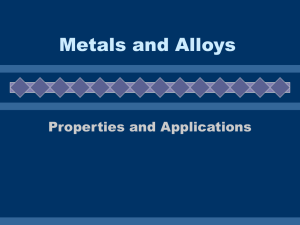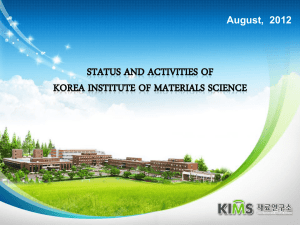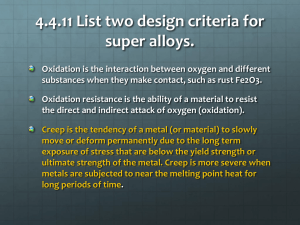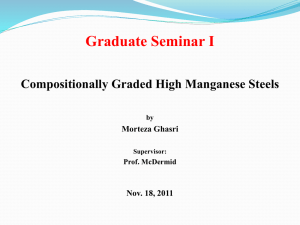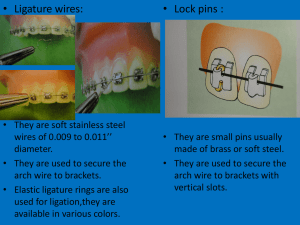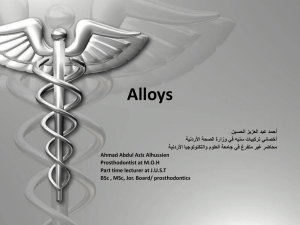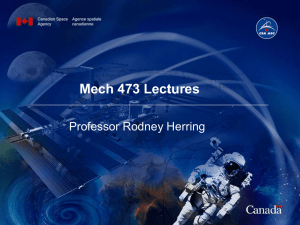chapter11
advertisement
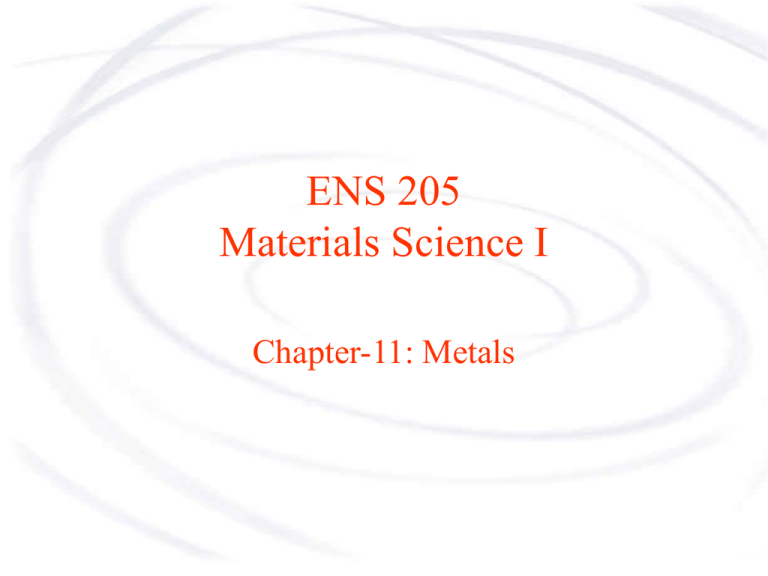
ENS 205 Materials Science I Chapter-11: Metals Metals • Steel generally contains: 0.05-2.0 wt. % C • Cast irons: 2.0-4.5 wt. % C • Total non-carbon addition > 5 wt. % → high-alloy steel, otherwise low alloy steel Classification of “Carbon Steels” There are four main groups of carbon steels 1. Low carbon steels (> 80% of the steel production) < 0.20 %C Used structural purposes. 2. Medium Carbon Steels 0.25 – 0.55 %C Used for machine parts. 3. Eutectoids Steels 0.6 – 0.8 %C Used for hard wearing rails. 4. Tools Steels 0.9 – 2.2 %C Used for tools and dies. Plain-carbon steels are designated most commonly by the American Iron and Steel Institute-Society of Automotive Engineers: AISI-SAE A four digit code is used: If the first two digits are 10, the steel is plain carbon steel. Other designations, ie., 20s, 30s, etc. refer to major alloying additions. The last two digits indicate the nominal carbon content of the steel in hundredths of a percent. Steels Plain-carbon steels are relatively low strength ( as steels go) but have very high ductility and relatively low cost – this is why the automotive industry likes it for auto body parts such as the panels for doors, roofs, hoods, etc. •It cannot be strengthened above ~690 Mpa (150,000 psi) without substantial loss in ductility and impact strength. •It has low resistance to corrosion and oxidation, so coatings such as Zn, Sn and paints are used for protection. •It has poor resistance to impact at low temperatures, having a BCC structure. •There’s difficulty in evenly heat treating large pieces, which creates a variability in properties. Alloy Steels So, there was a need to create better types of steels, which are alloy steels, ie., additions of alloys (low amounts of Mn, Ni, Cr, Ti, Si, etc) to improve its properties. •Alloying increases the cost of the steel, but the enhanced properties are essential in many applications. •Alloying improves corrosion resistance (particularly with the addition of Chromium), producing the stainless steels. •Alloying improves the hardenability, which is needed for tool steels •Hardenability means the ability of the steel to form martensite. •Alloying increases the solid solution strengthening of the ferrite phase •Alloying can produce a less brittle steel by causing the formation of carbides (WC, TiC, etc) other than Fe3C, which causes brittleness. “Stainless Steels” Stainless steels are another class of ferrous alloys, which have been made for and are used because of their excellent corrosion resistance. A true stainless steel has at least 12% Cr in the steel. This steel is exposed to oxygen, which forms a thin, stable Cr2O3 coating on the surface, which is very corrosion resistant. The Cr2O3 in the steel is very stable against attack by a number of chemicals and electrolytic corrosion actions. It is self healing if damaged. In general, there are four types of stainless steels based on their crystal structure and strengthening mechanisms. They are: •Ferritic stainless steels •Martensitic stainless steels •Austenitic stainless steels •Precipitation-hardened stainless steels Stainless Steel • The Austenitic Stainless Steel: austenite structure is retained in the room temperature by Ni (acts as substitutional atom): It has high corrosion resistance. • Ferritic Stainless Steel: Less nickel content than austenitic stainless steel: Used for applications not requiring the high corrosion resistance of the austenitic stainless steels. Less expensive • Martensitic Stainless steel: Excellent for applications for springs, and cutlery. • Precipitation hardening stainless steel: increased resistance to dislocation motion, thereby increased strength, or hardness. Used for corrosion resistance structural members. Stainless Steels Ferritic Stainless Steels The effect of Cr on the iron-carbon phase diagram is to stabilize the ferritic phase. •The ferritic or alpha phase (BCC) exists almost to room temperature. •Cr is BCC and extends the alpha region and suppresses the gamma (FCC) region. •At more than 12% Cr the gamma (FCC) phase does not form. •The ferritic stainless steels are relatively inexpensive because they do not contain Nickel. •Many Cr stainless steels contain up to 30% Cr and less than 0.12% C. •They have good strength but only moderate ductility and formability because of the BCC form. Stainless Steels Martensitic Stainless Steels These stainless steels can be produced by using a heat treatment that austenitizes the sample (above ~750 oC), followed by quenching to Room Temperature to get Martensite. •The Martensite can then be further strengthened by using tempering heat treatments. •These steels are not as resistant to corrosion as other stainless steels but they have a higher strength. •Applications include high-quality knives, ball-bearings and valves. Austenitic Stainless Steels These steels are formed by adding Ni, which is a strong austenite stabilizing element. •For example, 18% Cr and 8% Ni with 0.03% C will remain austenitic all the way to room temperature. •Low or no carbide formation in these stainless steels means that they can have high ductility, easy formability, high corrosion resistance and moderate strength. •Strength is obtained by solid solution strengthening and cold working. •They do not have any phase transitions as they are cooled so they do not become brittle at low temperatures. •High Ni and Cr content makes them expensive relative to other stainless steels. •Small amounts of Ti or Nb form TiC or NbC, which aid strength by precipitation without reducing corrosion resistance. Alloy designations for some common tool steels Used for cutting, forming, shaping other materials. The primary alloying elements used in these materials are tungsten, molybdenum, and chromium. Water hardening tool steels (W1) Cast Irons • The ferrous alloys with greater than 2 wt % carbon; • relatively low melting temperature, and liquid phase viscosities, • do not form undesirable surface films when poured, and undergo moderate shrinkage during the solidification. • Inferior mechanical properties compared with those of wrought alloys results from a less uniform microstructure including some porosity. • Four types cast irons: • White iron: has a characteristic of white, crystalline fracture surface: Large amounts of cementite are formed during casting, giving a hard brittle material. • Gray iron: has a gray fracture surface. Silicon content of (2-3 wt %) promotes graphite precipitation rather than cementite. • Ductile iron: addition of small amount of Mg (0.05 wt %) to the molten metal of gray-iron composition produces spheroidal graphite rather than graphite flakes. Ductility is improved by a factor of 20. and strength is doubled. • Malleable iron: which is cast as white iron and then heat-treated to produce nodular graphite precipitates. It has reasonable ductility. Nonferrous Alloys Structural metals and alloys are often divided into two major categories, ferrous and nonferrous materials. • Ferrous alloys are those based on iron as the principal metal and include steels, stainless steels, cast iron, etc, as discussed in our last lecture. • Approximately 90% of the world’s production of metals/alloys are ferrous because of their good strength, toughness, ductility and relatively low cost. Nonferrous alloys are those based on other metals with particular emphasis on Al, Cu, Ti, Zn, Zr, and Mg. Aluminum is an extremely useful engineering material as: • they are light weight and strong; Al has a density of 2700 kg/m3, which is about 1/3 that of steel. • their strength to weight ratio is excellent. • Al is non-toxic. • Al is one of the best metal electrical conductors • Al has good corrosion resistance due to its natural oxide layer, which is thin and passive once formed. Aluminum (cont’d) Aluminum is an extremely useful engineering material as: • Al stays ductile at low temperatures • Al has a relatively low price • It is the third most plentiful element on earth (next to oxygen and silicon). • Al is easily alloyed and many of its alloys are stronger than pure Al. • Al alloys are non-magnetic. • Al alloys have a stable or predictable microstructure. • Al alloys have an excellent machining, forming, and forging characteristics. • Al alloys have a relatively high thermal expansion. • Al alloys have a relatively high thermal conduction. - Al’s FCC crystal structure retains its strength, ductility and toughness at cryogenic temperatures. This is why we see many cryogenic tanks made from Al. Aluminum (cont’d) Disadvantages of Aluminum include: • Al has a low melting temperature so can’t be used at high temperatures (above ~ 400 C) • Al has low hardness so it is not good for wear resistance. • Because Al’s elastic modulus is 1/3 that of steel, it’s deflection as a structural component may be too great for the application. • Al’s FCC structure work hardens so it may become brittle after plastic deform and fracture easily. • Al’s high thermal expansion sometimes causes problems with its use as an interconnect for electronic devices. Good electronics use Cu alloys and the best use Au. Aluminum Alloys Aluminum alloys can be subdivided into two major groups based on their method of fabrication: •Wrought alloys •Cast alloys Wrought alloys are shaped by plastic deformation and have microstructures and compositions different from the casting alloys because of the differences in manufacturing requirements. Within each of these two major groups, they are further subdivided into two subgroups: •Heat treatable alloys •Non-heat treatable alloys Heat treatable alloys are strengthened by “age hardening”, whereas nonheat treatable alloys are strengthened by strain hardening. Age Hardening There are three steps to age harden materials such as Aluminum. 1. Solution Treatment – the alloy is heated above the solvus temperature into a single phase region of the phase diagram to dissolve any secondary phases such as precipitates. The material is held at this temperature until a homogeneous solid solution is produced. Al is usually solution-treated between 500 oC and 548 oC. 2. Quench – the alloy is rapidly cooled so the atoms do not have enough time to diffuse to potential nucleation sites. The alloy remains as a single phase material that is supersaturated with alloying elements. If the material is work hardened, the increase in dislocations density can be used as nucleation sites during aging. 3. Aged – The alloy is heated to a temperature below the solvus so the atoms can diffuse to numerous nucleation sites to produce precipitates. Nucleation of precipitates is enhanced by the presence of dislocations. Ideally, uniformly highly dispersed, ultrafine precipitates give the best effect in age hardening or precipitate strengthening. Age Hardening Age Hardening nuclei of the q precipitate, which is eventually forms in Al-Cu Alloys. The yield strength hardens by the formation of precipitates, which after longer times rippen (get large) and the strength falls off. The strength does not fall off at low aging temperatures. Requirements for Age Hardening Not all alloys are age hardenable. Four conditions must be satisfied for an alloy to have an age-hardened response during heat treatment. 1)The alloy system must display a decreasing solid solubility with decreasing temperature. In other words, the alloy must form a single phase on heating above the solvus line, then enter a two-phase region on cooling. 2) The matrix should be relatively soft and ductile, and the precipitate should be hard and brittle. In most age hardenable alloys, the precipitate is a hard, brittle intermetallic compound. 3) The alloy must be quenchable. Some alloys cannot be cooled rapidly enough to suppress the formation of the precipitate. Quenching may, however, introduce residual stresses that cause distortion of the part. To minimize residual stresses aluminum alloys are quenched in hot water, at about 80 oC, i.e., a hot quench. 4) A coherent precipitate must form. (see next slide) Many important alloys are age-hardenable including stainless steels and alloys based on aluminum, magnesium, titanium, nickel, chromium, iron, and copper. Noncoherent & Coherent Precipitates a) b) a) A noncoherent precipitate has no relationship with the crystal structure of the surrounding matrix. b) A coherent precipitate forms so that there is a definite relationship between the precipitate and the matrix’s crystal structure. The second digit indicates special purity controls http://www.azom.com/details.asp?ArticleID=310 http://httd.njuct.edu.cn/matweb/material/m_al.htm Copper Alloys The second large class of nonferrous alloys is the Cu-based alloys. Cu has a variety of properties, which make it useful in many applications. •High thermal conductivity •High electrical conductivity (Silver (Ag) is the highest!) •Good corrosion resistance •Cu and most of its alloys are FCC ; therefore toughness and ductility are retained at cryogenic temperatures. •Ease of fabrication •Medium tensile strength •Controllable microstructure – easily alloyed for higher strength •Easily soldered and joined, although it’s not easy to weld. •Relatively inexpensive Copper Alloys There are several ways to increase the strength of Cu alloys •They can be cold-worked or solid-solution strengthened •Cold-working has a substantial effect, much like it did for Al Alloys. •The process of age hardening is an important method of strengthening alloys of materials and it illustrates the power of knowledge of the phase diagrams and microstructures of materials. Copper Alloys The solid solution strengthening of Cu has produced many common engineering materials such as: Cu – Zn alloys are called “Brasses” •70% Cu – 30% Zn is called alpha brass because it is a single phase solid solution. •60% Cu – 30% Zn has two phases, alpha and beta brass. Cu – Sn alloys are called “Bronzes” •1-10% Sn forms solid solution strengthened alloys Cu – Be alloys typically contain 0.6-2% Be and 0.2-2.5% Co. •Precipitation hardened and cold working is possible – extremely high strength alloys are possible (~103 MPa), which is the highest of any commercial copper alloys •Used for springs, gears, valves, welding nozzles – relatively inexpensive. Nickel and Cobalt Alloys Nickel and Cobalt alloys are used for corrosion protection and for high-temperature resistance, taking advantage of their high melting points and high strengths. Nickel is FCC and has good formability. Cu-Ni is the classic example of complete solid solubility. Monel is the name given to commercial alloys with Ni-Cu ratios of roughly 2:1 by weight. These alloys are good examples of solution hardening in which the alloys are strengthened by the restriction of plastic deformation due to solid-solution formation. Cobalt is FCC above 417 oC and HCP below this temperature. Cobalt is used because of its exceptional wear resistance, and because of its resistance to body fluids, as a biomedical material for prosthetic devices such as hip and knee socket replacement. Typical alloys and their uses are listed in the following table. Superalloys: a broad class of materials with specially high strength at elevated temperatures Turbine blade design for active cooling by a gas shown in a) and the increase in the high-temperature capability of Ni superalloys as a result of improved manufacturing methods from producing a polycrystalline material to a single crystal material. Titanium Alloys While there are numerous other nonferrous alloys such as Mg, Zn, and Zr, which can be considered for special applications, the alloys that has received considerable attention is Titanium, Ti. •Ti is relatively light weight (4505 kg/m3) •Ti has excellent corrosion resistance, especially in sea water •Ti has a high strength to weight ratio •Some Ti alloys have a strength of over 150,000 psi (1000 MPa) •It’s surface oxide (TiO2) breaks down at ~500 C, which limits the range of its use, but surface coatings help to increase it’s range of use to much higher temperatures (~1000 C). •Ti has a HCP structure at room temperature and changes to BCC at 882 C – alloying with niobium stabilizes the BCC phase to room temperature, which enhances fabricability. •Typically, other elements added to Ti increase its strength and machinability. Refractory Alloys Refractory metals include tungsten (W), molybdenum (Mo), tantalum (Ta) and niobium (Nb). Their metallic bonds are weak resulting in low yield strengths. They have exceptionally high melting temperature (>1925 C) and so have high-temperature service. They have a BCC structure so they display a ductile to brittle transition temperature. Hot forming these materials aids their fabrication into useable products. Applications include filaments for light bulbs (tungsten), rocket nozzles, nuclear power generators (niobium), electronic capacitors (tantalum and niobium) and chemical processing equipment. Precious Metals These include gold, silver, palladium and rhodium. They are precious and expensive. These materials resist corrosion and make very good conductors of electricity. As a result alloys of these materials are often used as electrodes for devices. Because of their corrosion resistance, they are used as nano-sized particles as catalysts in automobile exhaust systems and in petroleum refining. In exhaust gases, they facilitate the oxidation of CO to CO2 and NOx to N2 and O2. Processing of Metals
